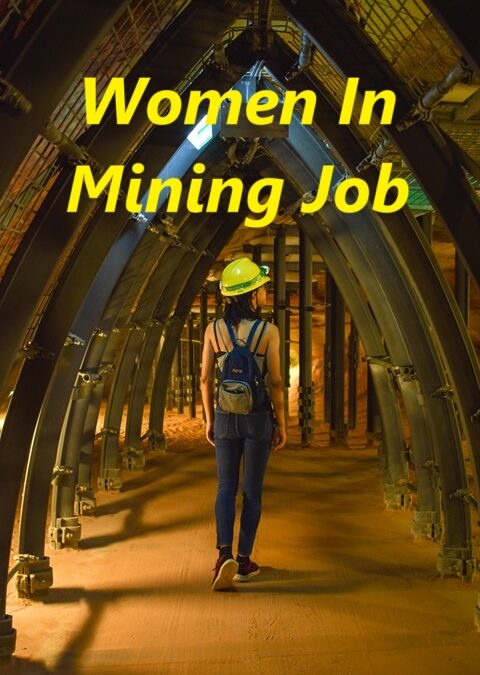Women’s in Mining Sector
For decades, mining remained a male-dominated industry, with women facing legal, cultural, and social restrictions that kept them away from working underground. The Indian mining sector, historically shaped by gender-based restrictions, witnessed a paradigm shift when the government lifted the long-standing ban on women working in underground mines in 2019. This milestone moment opened doors for countless women eager to prove their skills, resilience, and capabilities in the challenging world of mining.
The move was not just a legal amendment; it signified a new era of gender inclusivity, offering women opportunities in an industry that was previously off-limits. Today, women miners in India are breaking stereotypes, proving their mettle, and carving their space in one of the toughest professions.

Mining: A Male-Dominated Industry and the Historical Ban on Women
Mining has always been considered a physically demanding and hazardous job. From operating heavy machinery to working in dark, damp, and potentially dangerous underground tunnels, the profession is not for the faint-hearted. In India, these concerns translated into legislative barriers.
The ban on women working in underground mines dates back to the British colonial era. The Mines Act of 1952 strictly prohibited women from working in underground mines and restricted their involvement in certain surface mining jobs. The rationale behind this was largely centered on safety and societal norms that deemed mining as unsuitable for women.
As the years passed, while women made remarkable progress in various male-dominated sectors, mining continued to remain out of bounds. Even when technology improved and mechanization reduced physical labor in mining, the ban remained in place. However, the growing push for gender equality and the demand for a more inclusive workforce led to a historic decision in 2019—lifting the ban and allowing women to work in underground mining for the first time in independent India.

The Landmark 2019 Decision: Lifting the Ban on Women in Underground Mines
The year 2019 marked a turning point for the Indian mining industry. Responding to petitions and demands from women aspiring to enter the mining workforce, the central government took a progressive step by amending the mining regulations. Women were finally granted permission to work in underground mines if they chose to do so and if the necessary safety measures were in place.
This decision was widely welcomed by female engineering students, technical graduates, and skilled workers who had long been waiting for an opportunity to work in core mining operations. It was also a significant move toward gender equality, proving that women could handle the same work responsibilities as men.
One of the major developments following this decision was seen in state-owned coal mining companies such as Singareni Collieries, which started recruiting women miners. These trailblazing women became pioneers, paving the way for future generations.
Women Making History in the Indian Mining Sector

The impact of the 2019 decision was felt almost immediately, as women started joining the mining workforce. Their entry, however, was not without challenges. Mining had long been considered a “man’s world,” and societal perceptions needed to change along with the laws.
The First Batch of Women Miners
Among the first women to step into this new opportunity were those recruited by Singareni Collieries in Telangana. These women miners, equipped with technical education and determined spirits, broke barriers by working alongside their male counterparts.
One such woman, Allam Navyashree, recalls her journey into mining as both challenging and rewarding. Despite receiving skepticism from men who believed she was not fit for the role, she cleared all tests and entered the mines with confidence. Her story is a testament to the determination and courage of women entering this demanding profession.
Similarly, Srivastha, another pioneering woman miner, shared how she felt a sense of achievement when she descended into the underground tunnels for the first time. The experience of working deep beneath the earth, something that was once unimaginable for women, was now a reality.
Overcoming Societal Expectations
Many of these women miners had to overcome traditional societal pressures to pursue their dreams. In India, women are often expected to marry early and prioritize family responsibilities over careers. However, these miners defied such expectations, proving that women could balance both personal and professional aspirations.
Swathi, a young miner, shared how she resisted the pressure to marry early and instead focused on her career. She emphasized the importance of having family support, which played a crucial role in her success.
Challenges Faced by Women in the Mining Industry
Despite the historic progress made since 2019, women in mining continue to face several challenges. These include:
Workplace Infrastructure and Safety Concerns
Mining environments were originally designed for men, and adapting them for women has been an ongoing process. Basic facilities such as separate restrooms, changing rooms, and safety gear tailored for women have needed attention. While mining companies have started implementing these changes, much work remains.
Gender Bias and Stereotypes
Many male workers in the industry still hold the belief that mining is unsuitable for women. Some women miners have shared experiences of skepticism and resistance from their male colleagues. However, their dedication and hard work are gradually changing perceptions.
Physical and Mental Toughness
Mining is physically and mentally demanding. Long hours, underground conditions, and exposure to extreme environments require immense resilience. Women miners have shown that they are equally capable of handling these challenges, but it remains a tough profession.
Limited Career Growth Opportunities
While women have made progress in entering mining, they still face barriers in climbing the career ladder. Leadership roles in mining are still dominated by men, and it will take sustained efforts to ensure equal opportunities for career advancement.
The Road Ahead: A More Inclusive Mining Industry
The entry of women into the mining sector is just the beginning. Several initiatives can help make the industry more inclusive and supportive for women:
Encouraging More Women to Join Mining: Universities and technical institutes must promote mining as a viable career option for women.
Strengthening Workplace Policies: Ensuring anti-harassment policies, equal pay, and career growth opportunities can make the industry more welcoming.
Technology and Automation: With advancements in technology, mining is becoming less physically intensive. This opens doors for women to take on diverse roles in the industry.
Leadership and Mentorship Programs: More women need to be in leadership roles to inspire and guide the next generation of female miners.
Conclusion
The decision to lift the ban on women in underground mining in 2019 was a landmark moment in India’s labor history. Women have since stepped into this challenging field with determination, breaking barriers and proving their strength.
Although challenges remain, the progress made so far is a testament to the resilience and capability of women in mining. As the industry continues to evolve, gender inclusivity will play a key role in shaping the future of mining in India. The journey is not easy, but with the right policies, societal support, and a shift in mindset, women miners will continue to carve a new path in this once male-dominated sector.
Disclaimer
This blog is for informational purposes only and aims to provide insights into the opportunities and challenges faced by women in the Indian mining sector after the 2019 policy change. The information is derived from various sources and media reports, with efforts made to ensure accuracy and originality. Readers are advised to verify details from official government or mining industry sources before making any career-related decisions. The blog does not endorse or promote any particular mining company, policy, or political viewpoint. Any resemblance to real-life individuals is purely coincidental.


Recent Comments